Cleaner Cooking with Charcoal in Kibera Informal Settlement in Nairobi, Kenya, and Its Implications for Livelihoods and the Environment
Abstract
:1. Introduction
2. Materials and Methods
2.1. Study Area
2.2. Research Design
2.3. Selection of the Households and Baseline Survey
2.4. Baseline Survey
2.5. Participatory Cooking Test
2.5.1. Stoves Used to Cook
2.5.2. Fuel Used and Efficiency
2.5.3. Charcoal Burning Period
2.5.4. Measuring Indoor Air Concentration of Carbon Monoxide, Carbon Dioxide, Fine Particulate Matter, and Flame Temperature
2.6. Data Management and Analysis
3. Results and Discussions
3.1. Households’ Demographics
3.2. Stove and Fuel Mix or Stacking
3.3. Cost of the Cooking Fuel
3.4. Fuel Use Efficiency in Cooking
3.4.1. Burning Period
3.4.2. Charcoal Consumption and Use Efficiency
3.4.3. Concentration of Pollutants from Cooking with Charcoal and Potential Health and Climate Change Impacts
3.4.4. Study Limitations
4. Conclusions and Recommendations
Author Contributions
Funding
Data Availability Statement
Acknowledgments
Conflicts of Interest
References
- Food and Agriculture Organisation (FAO). Forest Pathways for Green Recovery and Building Inclusive, Resilient and Sustainable Economies. In Brief to The State of the World’s Forests 2022; FAO: Rome, Italy, 2022. [Google Scholar] [CrossRef]
- Chidumayo, E.N.; Gumbo, D.J. The environmental impacts of charcoal production in tropical ecosystems of the world: A synthesis. Energy Sustain. Dev. 2013, 17, 86–94. [Google Scholar] [CrossRef]
- Mensah, K.E.; Damnyag, L.; Kwabena, N.S. Analysis of charcoal production with recent developments in Sub-Sahara Africa: A review. Afric. Geo. Rev. 2022, 41, 35–55. [Google Scholar] [CrossRef]
- Food and Agriculture Organization (FAO). Global Forest Products. Forest Products and Statistics Team. Forestry Policy and Resources Division, Forestry Department. Food and Agriculture Organization of the United Nations. 2019. Available online: https://www.fao.org/forestry/statistics/80570/en/ (accessed on 22 May 2020).
- Haag, V.; Zemke, V.T.; Lewandrowski, T.; Zahnen, J.; Hirschberger, P.; Bick, U.; Koch, G. The European Charcoal Trade. IAWA J. 2020, 41, 463–477. [Google Scholar] [CrossRef]
- Ouedraogo, N.S. Africa energy future: Alternative scenarios and their implications for sustainable development strategies. Energy Pol. 2017, 106, 457–471. [Google Scholar] [CrossRef]
- Amowine, N.; Ma, Z.; Li, M..; Zhou, Z.; Asunka, B.A.; Amowine, J. Energy efficiency improvement assessment in Africa: An integrated dynamic DEA approach. Energies 2019, 12, 3915. [Google Scholar] [CrossRef]
- Ren, H.; Guo, W.; Zhang, Z.; Kisovi, L.M.; Das, P. Population density and spatial patterns of informal settlements in Nairobi, Kenya. Sustainability 2020, 12, 7717. [Google Scholar] [CrossRef]
- Akpalu, W.; Dasmani, I.; Aglobitse, P.B. Demand for cooking fuels in a developing country: To what extent do taste and preferences matter? Energy Pol. 2011, 39, 6525–6531. [Google Scholar] [CrossRef]
- Smith, H.E.; Hudson, M.D.; Schreckenberg, K. Livelihood diversification: The role of charcoal production in southern Malawi. Energy Sustain. Dev. 2017, 36, 22–36. [Google Scholar] [CrossRef]
- FAO 2023. FAOSTAT Statistical Database. [Rome]: Food and Agriculture Organization of the United Nations. Available online: https://www.fao.org/faostat/en/#data/FO (accessed on 3 February 2023).
- Iiyama, M.; Chenevoy, A.; Otieno, E.; Kinyanjui, T.; Ndegwa, G.; Vandenabeele, J.; Njenga, M.; Johnson, O. Achieving Sustainable Charcoal in Kenya: Harnessing the Opportunities for Cross Sectoral Integration; World Agroforestry (ICRAF): Nairobi, Kenya; Stockholm Environment Institute (SEI): Nairobi, Kenya, 2014. [Google Scholar]
- Namaswa, T.; Githiomi, J.; Oduor, N.; Kitheka, E. Sustainable biomass energy production and utilization in sub-Saharan Africa: A case study of Kenya. J. Hortic. For. 2022, 14, 56–67. [Google Scholar]
- Ministry of Energy (MoE); Cleaner Cooking Association of Kenya (CCAK). Kenya Household Cooking Sector Study. Assessment of the Supply and Demand of Cooking Solutions at the Household Level; CCAK and Ministry of Energy: Nairobi, Kenya, 2019.
- Njenga, M.; Larsson, L.; Iiyama, M.; Sundberg, C.; Helander, H.; Röing de Nowina, K.; De Leeuw, J.; Neufeldt, H.; Jamnadass, R. Gasifier as a cleaner cooking system in rural Kenya. J. Clean Prod. 2016, 121, 208–217. [Google Scholar] [CrossRef]
- Branch, A.; Agyei, F.K.; Anai, J.G.; Apecu, S.L.; Bartlett, A.; Brownell, E.; Caravani, M.; Cavanagh, C.J.; Fennell, S.; Langole, S.; et al. From crisis to context: Reviewing the future of sustainable charcoal in Africa. Energy Res. Soc. Sci. 2022, 87, 102457. [Google Scholar] [CrossRef]
- World Health Organisation. World Health Statistics 2018: Monitoring Health for the Sustainable Development Goals (SDGs). 2018. Available online: https://www.who.int/en/news-room/fact-sheets/detail/household-air-pollution-and-health (accessed on 27 August 2020).
- Qiu, Y.; Yang, F.A.; Lai, W. The impact of indoor air pollution on health outcomes and cognitive abilities: Empirical evidence from China. Popul. Environ. 2019, 40, 388–410. [Google Scholar] [CrossRef]
- Li, S.; Meng, J.; Zheng, H.; Zhang, N.; Huo, J.; Li, Y.; Guan, D. The driving forces behind the change in energy consumption in developing countries. Environ. Res. Lett. 2021, 16, 054002. [Google Scholar] [CrossRef]
- Kim, H.; Kang, K.; Kim, T. Measurement of particulate matter (PM2.5) and health risk assessment of cooking-generated particles in the kitchen and living rooms of apartment houses. Sustainability 2018, 10, 843. [Google Scholar] [CrossRef]
- Bailis, R.; Cowan, A.; Berrueta, V.; Masera, O. Arresting the Killer in the Kitchen: The Promises and Pitfalls of Commercializing Improved Cook stoves. World Dev. 2009, 10, 1694–1705. [Google Scholar] [CrossRef]
- Njenga, M.; Sears, R.R.; Mendum, R. Sustainable woodfuel systems: A theory of change for sub-Saharan Africa. Environ. Res. Comm. 2023, 5, 051003. [Google Scholar] [CrossRef]
- Yang, C.; Wu, H.; Cai, M.; Zhou, Y.; Guo, C.; Han, Y.; Zhang, L. Valorization of Biomass-Derived Polymers to Functional Biochar Materials for Supercapacitor Applications via Pyrolysis: Advances and Perspectives. Polymers 2023, 15, 2741. [Google Scholar] [CrossRef]
- Lambe, F.; Jürisoo, M.; Wanjiru, H.; Senyagwa, J. Bringing Clean, Safe, Affordable Cooking Energy to Households Across Africa: An Agenda for Action; Stockholm Environment Institute: Stockholm, Sweden; Nairobi, Kenya, 2015. [Google Scholar]
- Mahmoud, Y.; Njenga, M.; Sundberg, C.; De Nowina, K.R. Soils, sinks, and smallholder farmers: Examining the benefits of biochar energy transitions in Kenya. Energy Res. Soc. Sci. 2021, 75, 102033. [Google Scholar] [CrossRef]
- Guta, D.; Baumgartner, J.; Jack, D.; Carter, E.; Shen, G.; Orgill-Meyer, J.; Rosenthal, J.; Dickinson, K.; Bailis, R.; Masuda, Y.; et al. A systematic review of household energy transition in low and middle income countries. Energy Res. Soc. Sci. 2022, 86, 102463. [Google Scholar] [CrossRef]
- Gill-Wiehl, A.; Price, T.; Kammen, D.M. What’s in a stove? A review of the user preferences in improved stove designs. Energy Res. Soc. Sci. 2021, 81, 102281. [Google Scholar] [CrossRef]
- Bielecki, C.; Wingenbach, G. Rethinking improved cook stove diffusion programs: A case study of social perceptions and cooking choices in rural Guatemala. Energy Pol. 2014, 66, 350–358. [Google Scholar] [CrossRef]
- Kitheka, E.; Kimiti, J.M.; Oduor, N.; Mutinda, J.W.; Ingutia, C.; Githiomi, J. Factors influencing adoption of biomass energy conservation technologies in selected areas of Kitui County, Kenya. J. Environ. Sci. Eng. 2019, 8, 70–81. [Google Scholar]
- Gill-Wiehl, A.; Sievers, S.; Kammen, D.M. The value of community technology workers for LPG use: A pilot in Shirati, Tanzania. Energy Sustain. Soc. 2022, 12, 5. [Google Scholar] [CrossRef]
- Schot, J.; Kanger, L.; Verbong, G. The roles of users in shaping transitions to new energy systems. Nat. Energy 2016, 1, 16054. [Google Scholar] [CrossRef]
- Williams, N.B.; Quilliam, R.S.; Campbell, B.; Ghatani, R.; Dickie, J. Taboos, toilets and biogas: Socio-technical pathways to acceptance of a sustainable household technology. Energy Res. Soc. Sci. 2022, 86, 102448. [Google Scholar] [CrossRef]
- Wahlund, M.; Palm, J. The role of energy democracy and energy citizenship for participatory energy transitions: A comprehensive review. Energy Res. Soc. Sci. 2022, 87, 102482. [Google Scholar] [CrossRef]
- Energy Sector Management Assistance Program (ESMAP). What Drives the Transition to Modern Energy Cooking Services? A Systematic Review of the Evidence; Technical Report 015/21; World Bank: Washington, DC, USA, 2021. [Google Scholar]
- Shankar, A.V.; Quinn, A.K.; Dickinson, K.L.; Williams, K.N.; Masera, O.; Charron, D.; Jack, D.; Hyman, J.; Pillarisetti, A.; Bailis, R.; et al. Everybody stacks: Lessons from household energy case studies to inform design principles for clean energy transitions. Energy Pol. 2020, 141, 111468. [Google Scholar] [CrossRef]
- Ochieng, C.A.; Zhang, Y.; Nyabwa, J.K.; Otieno, D.I.; Spillane, C. Household perspectives on cook stove and fuel stacking: A qualitative study in urban and rural Kenya. Energy Sustain. Dev. 2020, 59, 151–159. [Google Scholar] [CrossRef]
- Ministry of Environment, Water and Natural Resources (MEWNR), Government of Kenya (GoK). Analysis of Demand and Supply of Wood Products in Kenya; Government of Kenya: Nairobi, Kenya, 2013.
- United Nations Human Settlements Programme (UN-Habitat). UN-Habitat Support to Sustainable Urban Development in Kenya: Addressing Urban Informality. 2016. Available online: https://unhabitat.org/sites/default/files/download-manager-files/UN-Habitat%20SSUDK_%20Report_Vol%204_final.LowRes.pdf (accessed on 27 June 2023).
- Kenya National Bureau of Statistics (KNBS). The 2019 Kenya Population and Housing Census: Population by County and Sub-County, KNBS 2019; Kenya National Bureau of Statistics: Nairobi, Kenya, 2019.
- Bodewes, C. Parish Transformation in Urban Slums: Voices of Kibera, Kenya; Paulines Publications Africa: Nairobi, Kenya, 2005. [Google Scholar]
- Njenga, M.; Kirimi, M.; Koech, G.; Erick Otieno, W.; Muriuki, J.; Sola, P.; Bourne, M.; Siko, I.; Mendum, R. Improvements in Charcoal Production and the Environmental Implications: Potential for the Invasive Prosopis Juliflora in Kenya. SSRN Electron. J. 2022. [Google Scholar] [CrossRef]
- Njenga, M.; Mahmoud, Y.; Mendum, R.; Iiyama, M.; Jamnadass, R.; De Nowina, K.R.; Sundberg, C. Quality of charcoal produced using micro gasification and how the new cook stove works in rural Kenya. Environ. Res. Lett. 2017, 12, 095001. [Google Scholar] [CrossRef]
- Kenya National Bureau of Statistics (KNBS). The Kenya 2009 Population and Housing Census; Population Distribution by Administrative Units; KNBS: Nairobi, Kenya, 2010; Volume 1A.
- Njenga, M.; Karanja, N.; Jamnadass, R.; Kithinji, J.; Sundberg, C.; Jirjis, R. Quality of briquettes produced locally from charcoal dust and sawdust in Kenya. J. Bio. Mater. Biol. 2013, 7, 315–322. [Google Scholar] [CrossRef]
- Oduor, N.M.; Ngugi, W.; Wa Gathui, T. Sustainable Tree Management for Charcoal Production Acacia Species in Kenya; African Centre for Technology Studies (ACTS): Nairobi, Kenya, 2012. [Google Scholar]
- Oduor, N.; Githiomi, J.K. Fuel-wood energy properties of Prosopis juliflora and Prosopis pallida grown in Baringo District, Kenya. Afr. J. Agric. Res. 2013, 8, 2476–2481. [Google Scholar]
- Sirmah, P.; Muisu, F.; Mburu, F.; Dumarçay, S.; Gérardin, P. Evaluation of Prosopis juliflora properties as an alternative to wood shortage in Kenya. Boiset Forêts Trop. 2008, 298, 25–35. [Google Scholar]
- BURN-Manufacturing. Winner Case Study Summary—Case Study; BURN Manufacturing: Nairobi, Kenya, 2015. [Google Scholar]
- World Health Organisation. WHO Guidelines for Indoor Air Quality on Selected Pollutants. 2010. Available online: https://apps.who.int/iris/bitstream/handle/10665/260127 (accessed on 27 August 2020).
- World Health Organisation, Climate and Clean Air Coalition. Air Pollution, Climate and Health. 2016. Available online: https://www.who.int/sustainabledevelopment/AirPollution_Climate_Health_Factsheet.pdf (accessed on 28 August 2020).
- Muindi, K. Household air pollution: Sources and exposure levels to fine particulate matter in Nairobi slums. Toxics 2016, 4, 12. [Google Scholar] [CrossRef]
- Strode, S.A.; Duncan, B.N.; Yegorova, E.A.; Kouatchou, J.; Ziemke, J.R.; Douglass, A.R. Implications of carbon monoxide bias for methane lifetime and atmospheric composition in chemistry climate models. Atmos. Chem. Phys. 2015, 15, 11789–11805. [Google Scholar] [CrossRef]
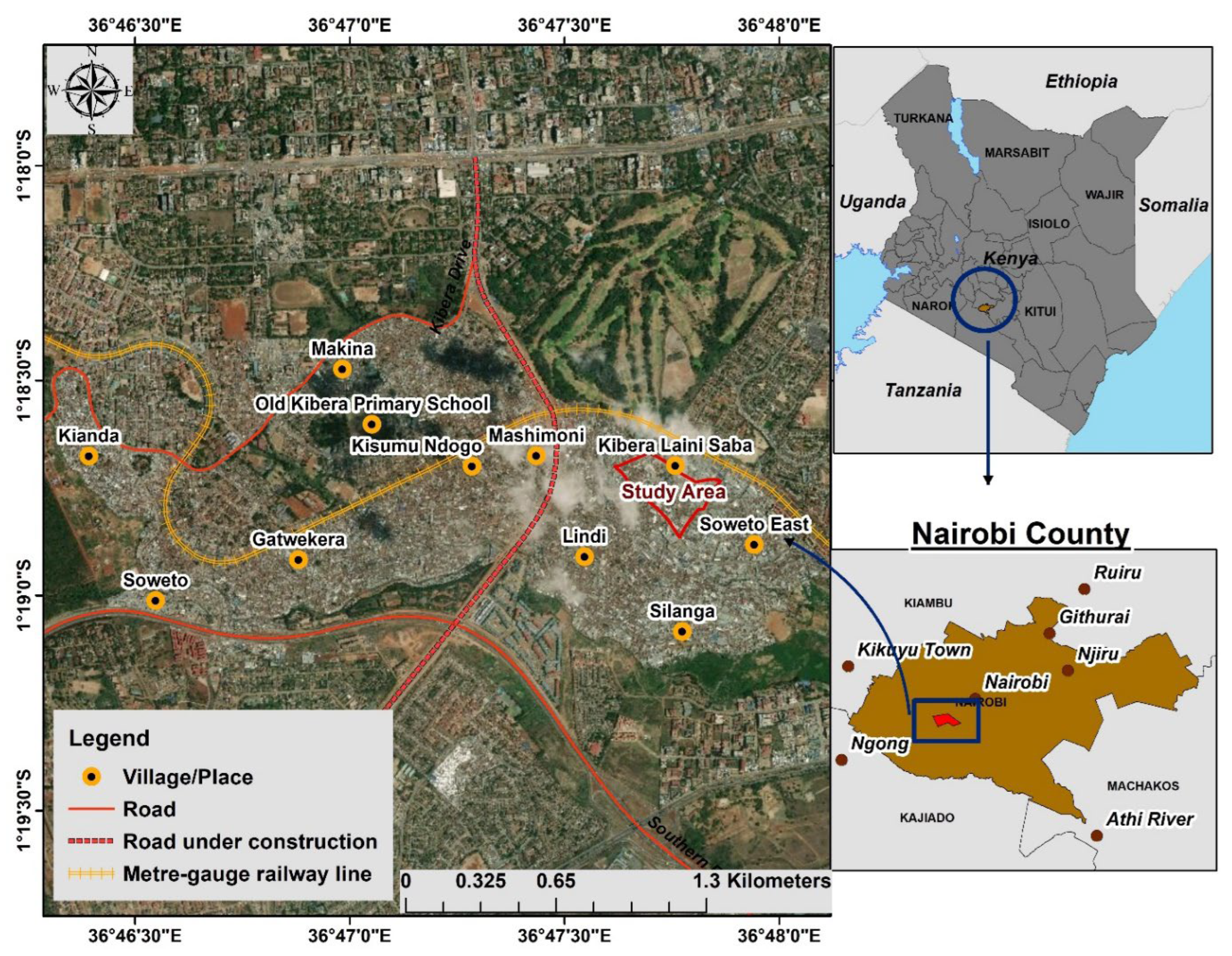
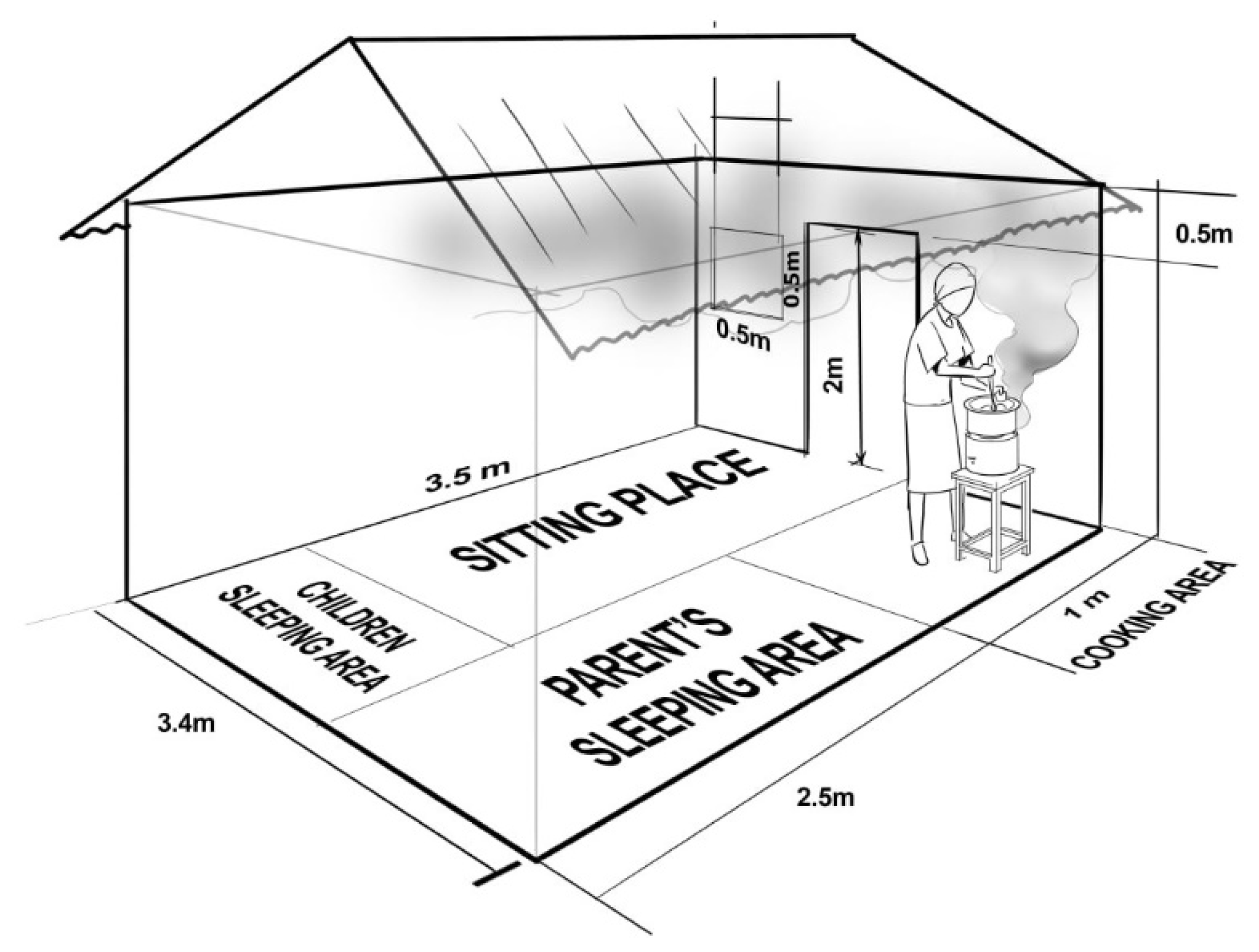
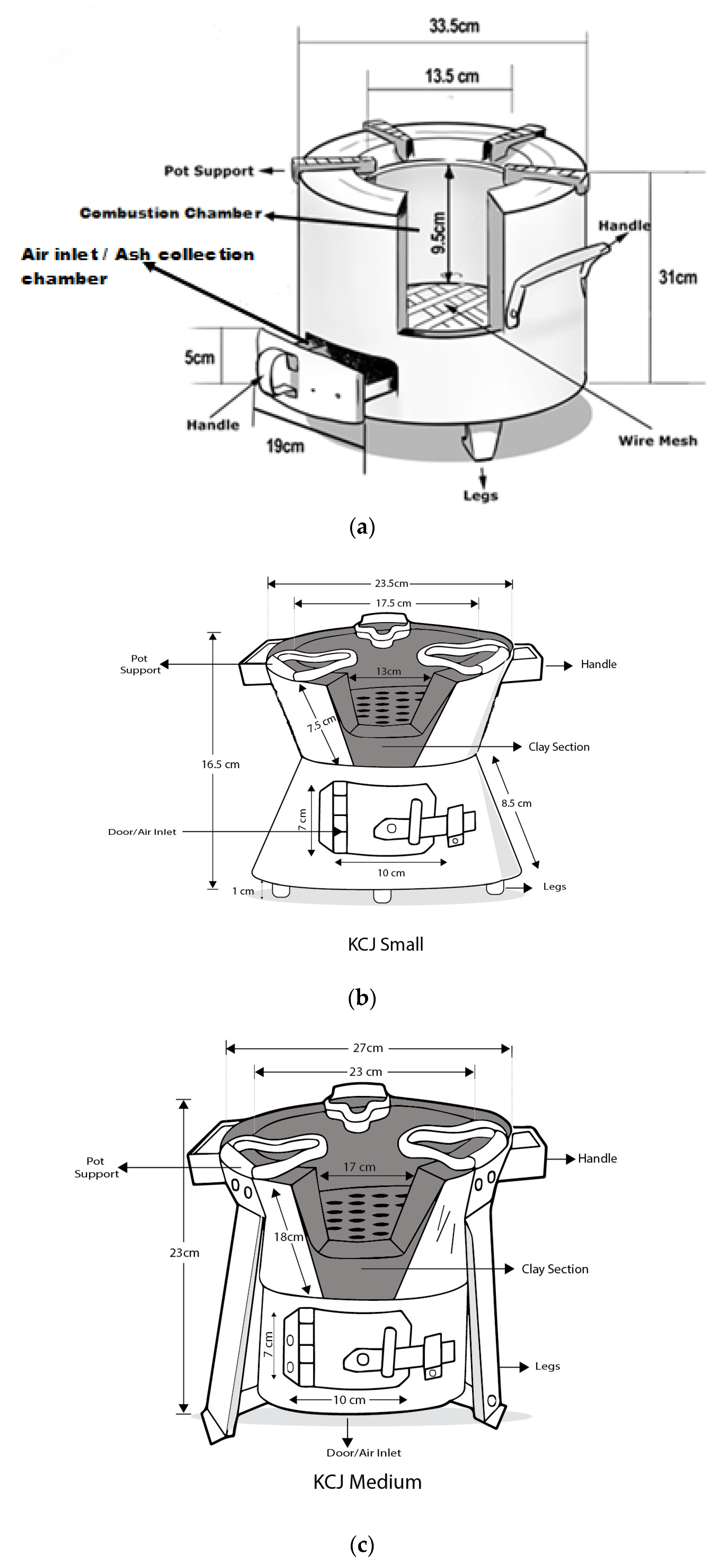

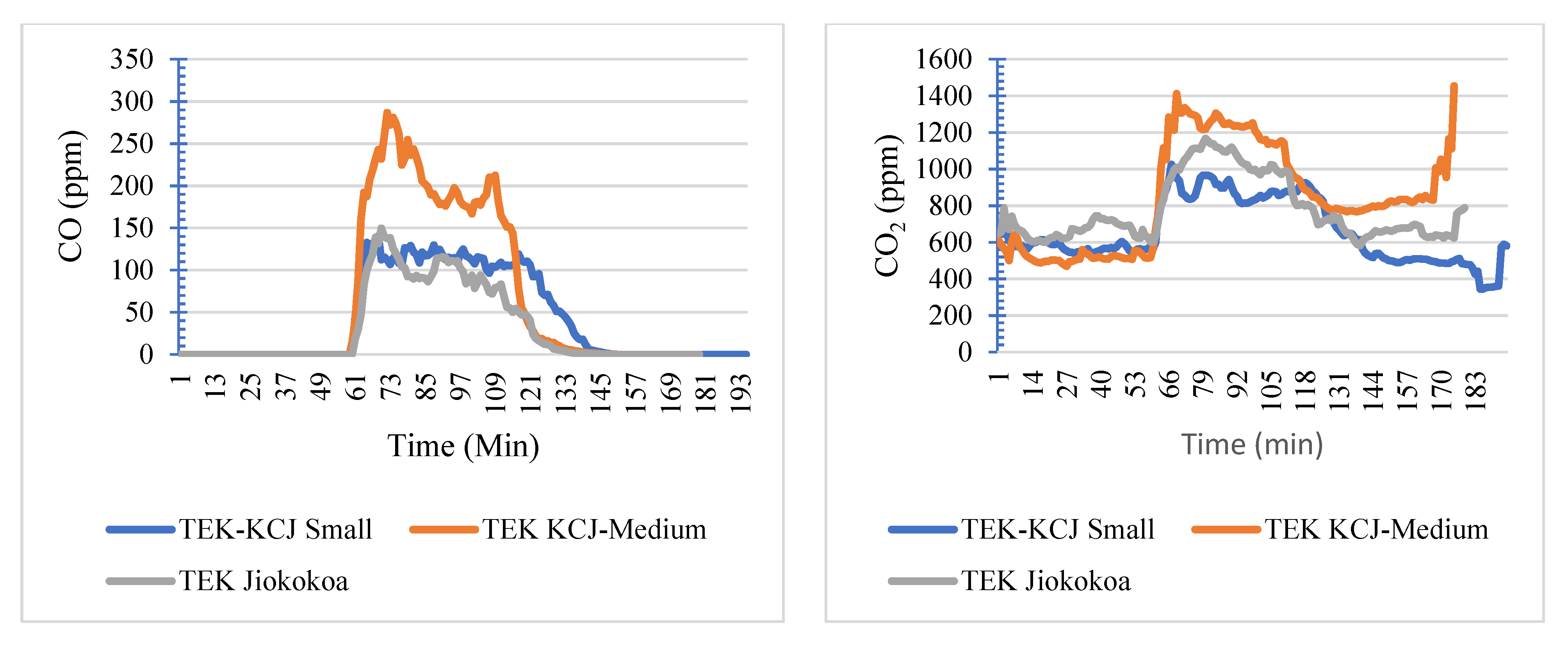
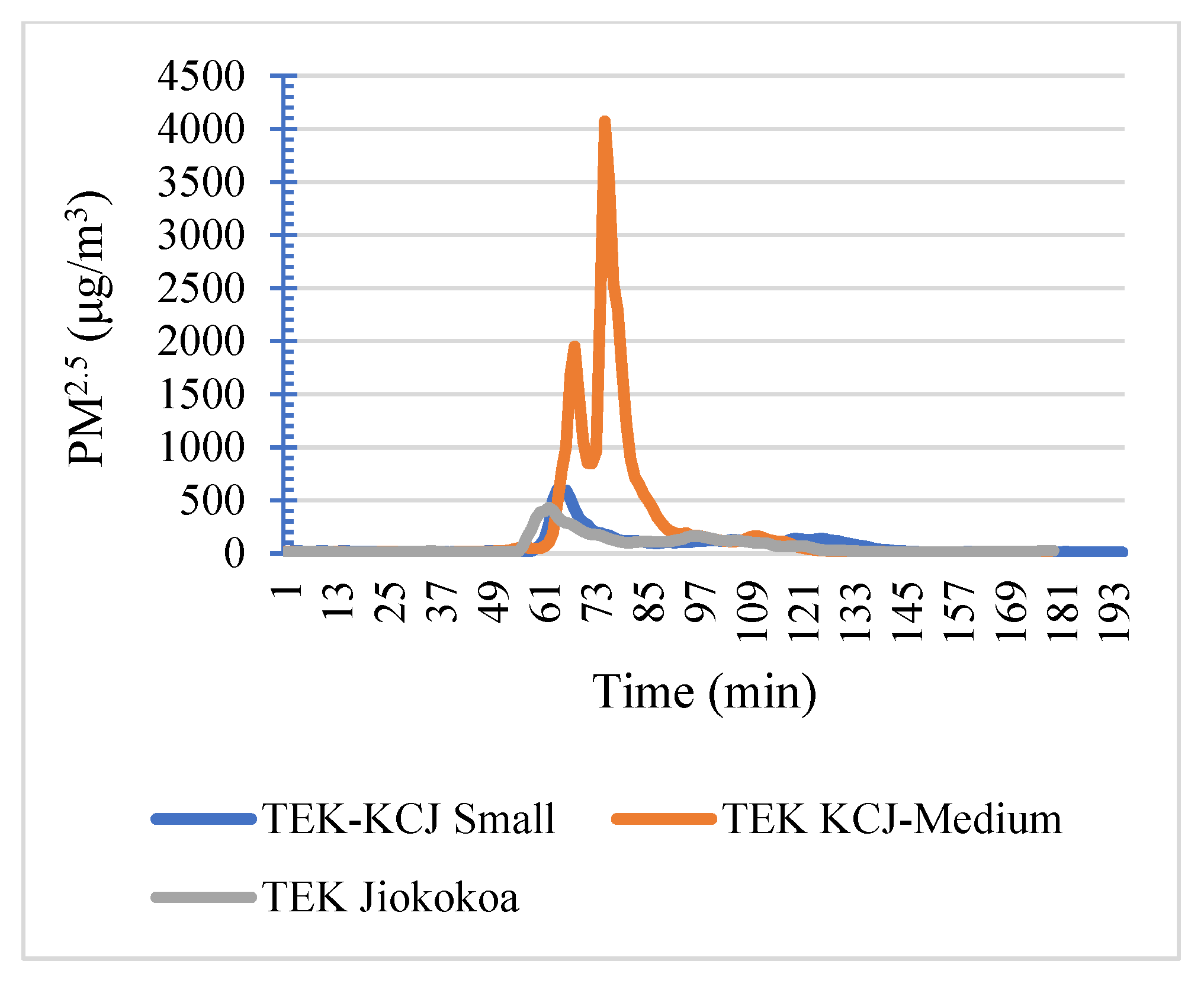
| Household’s Main Cook | Relationship to HH | Male-Headed HH | Female-Headed HH | No. of HH | % HH |
|---|---|---|---|---|---|
| Wife | Wife to HHH | 12 | 12 | 50 | |
| Female head | HHH | 4 | 4 | 16.7 | |
| Male head | HHH | 2 | 2 | 8.3 | |
| Daughter | Daughter to FH | 3 | 3 | 12.5 | |
| Brother | Brother to MH | 1 | 1 | 4.2 | |
| Son, sister, and brother cook in turns | Son, sister, and brother to FH | 1 | 1 | 4.2 | |
| Daughter in law | Daughter in law to FH | 1 | 1 | 4.2 |
| Fuel Type | HH (%) | Percent Contribution to the Fuel Mix | ||||
|---|---|---|---|---|---|---|
| Charcoal | Kerosene | LPG | Electricity | Ethanol | ||
| Charcoal + kerosene | 6 (25) | 42.1 | 57.9 | |||
| Charcoal + kerosene + LPG | 5 (20.8) | 15.2 | 20 | 64.8 | ||
| Electricity + charcoal + kerosene + LPG | 4 (16.7) | 23.7 | 13.7 | 26.6 | 36 | |
| Electricity + charcoal + LPG | 2 (8.3) | 6.7 | 62.2 | 31.1 | ||
| Kerosene + LPG | 2 (8.3) | 33.3 | 66.7 | |||
| Kerosene only | 2 (8.3) | 100 | ||||
| Kerosene + ethanol | 1 (4.2) | 85.7 | 14.3 | |||
| Electricity + charcoal | 1 (4.2) | 41.7 | 58.3 | |||
| LPG only | 1 (4.2) | 100 | ||||
| Fuel Type | HH (%) | Frequency of Use per Month | ||||
|---|---|---|---|---|---|---|
| Charcoal | Kerosene | LPG | Electricity | Ethanol | ||
| Charcoal + kerosene | 6 (25) | 35.7 | 45.3 | |||
| Charcoal + kerosene + LPG | 5 (20.8) | 15.6 | 18.2 | 50.4 | ||
| Electricity+ charcoal + kerosene + LPG | 4 (16.7) | 18 | 8.5 | 20 | 32 | |
| Electricity + charcoal + LPG | 2 (8.3) | 6 | 56 | 28 | ||
| Kerosene + LPG | 2 (8.3) | 28 | 56 | |||
| Kerosene only | 2 (8.3) | 59 | ||||
| Kerosene + ethanol | 1 (4.2) | 48 | 8 | |||
| Electricity + charcoal | 1 (4.2) | 40 | 46 | |||
| LPG only | 1 (4.2) | 56 | ||||
| Fuel | Unit of Measure | No. Households Buy in the Unit | Cost per Unit of Measure (Kes) | How Long a Unit of Measure Is Used | Number of Units Used per Month | Cost per Month (Kes) |
|---|---|---|---|---|---|---|
| Charcoal | Kasuku | 17 | 54.12 | 0.97 of a day | 18.53 Kasukus | 1032.35 |
| Mkebe | 1 | 40 | 1 day | 4 Mkebes | 160 | |
| Kerosene | 150 mL | 1 | 20 | 1 day | 2 | 40 |
| 300 mL | 7 | 42.86 | 1.57 days | 15.57 | 607.14 | |
| 500 mL | 8 | 53.75 | 1.56 days | 16.88 | 888.75 | |
| litre | 4 | 94.5 | 3 days | 7 | 693 | |
| LPG | 6 kg cylinder | 13 | 908 | 2.15 months | 0.57 of 6 kg cylinder | 518.62 |
| 13 kg cylinder | 1 | 1900 | 3 months | 0.33 of 13 kg cylinder | 633.33 | |
| Electricity | Pay monthly | 7 | 342.86 | 1 month | One pay per month | 342.86 |
| Ethanol | litre | 1 | 80 | 3 days | 2.5 L | 200 |
| Fuel Mix | Average Cost per Month (KES) for the Energy Types | Total Cost of the Mix (KES) | ||||
|---|---|---|---|---|---|---|
| Charcoal | Kerosene | LPG | Electricity | Ethanol | ||
| Charcoal + kerosene | 1295 | 1058 | 2353 | |||
| Charcoal + kerosene + LPG | 832 | 418 | 572 | 1822 | ||
| Electricity + charcoal + kerosene + LPG | 1055 | 348 | 392 | 350 | 2145 | |
| Electric + charcoal + LPG | 330 | 700 | 250 | 1280 | ||
| Kerosene + LPG | 795 | 625 | 1420 | |||
| Kerosene only | 950 | 950 | ||||
| Kerosene + ethanol | 850 | 200 | 1050 | |||
| Electricity + charcoal | 900 | 500 | 1400 | |||
| LPG only | 300 | 300 | ||||
| Species Types and Kiln Used | Small-Sized KCJ | Jikokoa |
|---|---|---|
| P. juliflora TEK | 1 h:44 min | 1 h:55 min |
| P. juliflora IEK | 1 h:43 min | 1 h:54 min |
| A. tortilis TEK | 2 h:20 min |
| Charcoal Types | Kilns Used | Small-Sized KCJ | Medium-Sized KCJ | Jikokoa Stove | ||||||
|---|---|---|---|---|---|---|---|---|---|---|
| Gross | Net | % Fuel Saving | Gross | Net | % Fuel Saving | Gross | Net | % Fuel Saving | ||
| Fuel Used (g) | Fuel Used (g) | Fuel Used (g) | ||||||||
| P. juliflora | TEK | 373.5 | 288.8 | 22.7 | 537.7 | 366.3 | 31.9 | 361.5 | 270.2 | 25.3 |
| P. juliflora | IEK | 398.2 | 314.3 | 21.1 | - | - | - | 392.5 | 282.2 | 28.1 |
| P. juliflora | DK | 391.5 | 329.3 | 15.9 | - | - | - | 391.3 | 333.0 | 14.9 |
| A. tortilis | TEK | 441.7 | 277.8 | 37.1 | - | - | - | 489.8 | 308.2 | 37.1 |
| Average | 401.2 | 302.6 | 24.2 | 537.7 | 366.3 | 31.9 | 408.8 | 298.4 | 26.3 | |
| Type of Kiln and Charcoal | Flame Temperature (°C) | ||
|---|---|---|---|
| Small-Sized KCJ | Jikokoa | Medium-Sized KCJ | |
| TEK P. juliflora | 658.88 | 722.96 | 715.96 |
| IEK P. juliflora | 659.39 | 691.93 | - |
| DK P. juliflora | 639.41 | 714.57 | - |
| TEK A. tortilis | 698.92 | 728.92 | - |
| Average | 664.15 | 714.59 | 715.96 |
| Charcoal Kiln | Stove | CO (ppm) | CO2 (ppm) | PM2.5 (μg/m3) | Time Taken to Cook (min) |
|---|---|---|---|---|---|
| TEK P. juliflora | Small-sized KCJ | 116.3 ± 5.3 | 885.2 ± 25.2 | 182.3 ± 14.2 | 63 |
| Medium-sized KCJ | 210.1 ± 11.5 | 1228.1 ± 48.8 | 732.8 ± 136.0 | 50 | |
| Jikokoa | 104.9 ± 5.2 | 1036 ± 22.8 | 171.4 ± 14.8 | 49 | |
| IEK P. juliflora | Small-sized KCJ | 218.3 ± 11.3 | 1214.0 ± 31.8 | 205.2 ± 13.8 | 64 |
| Jikokoa | 255 ± 18.1 | 1344.9 ± 47.3 | 2128.8 ± 496.9 | 44 | |
| DK P. juliflora | Small-sized KCJ | 208.6 ± 10.2 | 390.4 ± 16.7 | 902.5 ± 107.9 | 56 |
| Jikokoa | 238.7 ± 15.0 | 1109.7 ± 34.5 | 1544.9 ± 29.7 | 45 | |
| TEK A. tortilis | Small-sized KCJ | 138.1 ± 9.3 | 1179.9 ± 36.1 | 62.0 ± 4.0 | 60 |
| Jikokoa | 119.1 ± 9.0 | 944.5 ± 37.7 | 82.9 ± 22.0 | 41 |
| Charcoal Kiln and Species | Stove | Charcoal Burnt (kg) | Emissions in kg of Pollutants | GWP * (CO and CO2) kg per Meal Cooked | |||
|---|---|---|---|---|---|---|---|
| CO | CO2 | PM2.5 | GWP100 | GWP20 | |||
| TEK P. juliflora | Medium-sized KCJ | 0.366 | 0.14103 | 0.87347 | 0.00026 | 1.44634 | 2.17396 |
| Small-sized KCJ | 0.289 | 0.10619 | 0.69654 | 0.00009 | 1.1279 | 1.67580 | |
| Jikokoa | 0.270 | 0.07279 | 0.69324 | 0.00006 | 0.9889 | 1.36442 | |
| IEK P. juliflora | Small-sized KCJ | 0.314 | 0.12645 | 0.74093 | 0.00006 | 1.25459 | 1.90702 |
| Jikokoa | 0.282 | 0.11407 | 0.66424 | 0.00050 | 1.12758 | 1.71609 | |
| DK P. juliflora | Small-sized KCJ | 0.329 | 0.21818 | 0.64163 | 0.00050 | 1.52788 | 2.65356 |
| Jikokoa | 0.333 | 0.15839 | 0.74008 | 0.00054 | 1.38345 | 2.20064 | |
| TEK A. tortilis | Small-sized KCJ | 0.278 | 0.07938 | 0.70430 | 0.00002 | 1.02675 | 1.43632 |
| Jikokoa | 0.308 | 0.10520 | 0.75590 | 0.00005 | 1.18322 | 1.72599 | |
Disclaimer/Publisher’s Note: The statements, opinions and data contained in all publications are solely those of the individual author(s) and contributor(s) and not of MDPI and/or the editor(s). MDPI and/or the editor(s) disclaim responsibility for any injury to people or property resulting from any ideas, methods, instructions or products referred to in the content. |
© 2023 by the authors. Licensee MDPI, Basel, Switzerland. This article is an open access article distributed under the terms and conditions of the Creative Commons Attribution (CC BY) license (https://creativecommons.org/licenses/by/4.0/).
Share and Cite
Kirimi, M.; Gitau, J.K.; Mendum, R.; Muthuri, C.; Njenga, M. Cleaner Cooking with Charcoal in Kibera Informal Settlement in Nairobi, Kenya, and Its Implications for Livelihoods and the Environment. Energies 2023, 16, 6808. https://doi.org/10.3390/en16196808
Kirimi M, Gitau JK, Mendum R, Muthuri C, Njenga M. Cleaner Cooking with Charcoal in Kibera Informal Settlement in Nairobi, Kenya, and Its Implications for Livelihoods and the Environment. Energies. 2023; 16(19):6808. https://doi.org/10.3390/en16196808
Chicago/Turabian StyleKirimi, Moses, James K. Gitau, Ruth Mendum, Catherine Muthuri, and Mary Njenga. 2023. "Cleaner Cooking with Charcoal in Kibera Informal Settlement in Nairobi, Kenya, and Its Implications for Livelihoods and the Environment" Energies 16, no. 19: 6808. https://doi.org/10.3390/en16196808







